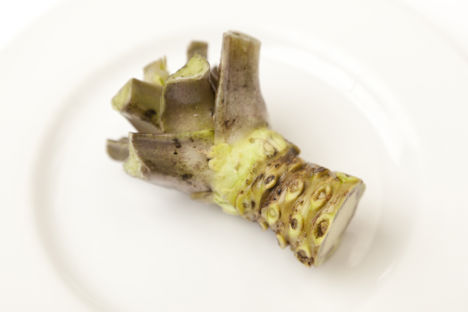
Flavours of Japan: wasabi
Sally Abé sheds some light on the fiery bright green root beloved in Japanese cooking and looks into how it pairs with other flavours.
Flavours of Japan: wasabi
Sally Abé sheds some light on the fiery bright green root beloved in Japanese cooking and looks into how it pairs with other flavours.
There is evidence of wasabi being used as far back as 14,000 BC in ancient Japan, and it is still most associated with the country’s cuisine today, particularly sushi, as the antibacterial properties of the plant can kill bacteria in raw fish. It is part of the brassica family, similar to horseradish, and while generally thought of as a root it is in fact a stem. The whole plant can be eaten, including the leaves and flowers, and it takes two years to grow big enough to be harvested, hence its high price.
Wasabi is very hard to grow commercially, particularly outside Japan, but some companies in the UK are using watercress beds to mimic the moist environment needed to cultivate it. Fresh wasabi is very different to the pastes available in the supermarkets; the stem loses both flavour and pungency after just ten minutes of grating and pastes generally contain less than three percent actual wasabi – the rest is a combination of food colouring and horseradish.
Flavour profile
The clean, white heat of wasabi is similar to the ‘burn’ of horseradish or mustard, which is caused by the vapour the plant produces. It is aromatic, pungent, fresh, sweet and exhilarating, resulting in a burning sensation in your nose. Wasabi has just two flavour directions – pungent, something that is generally found in mustard, but also in green and red cabbage, cauliflower, Brussels sprouts, sauerkraut and kale, and green, which can be linked to cucumber, avocado, broad beans, coriander, dill and olive oil as well as crayfish, mackerel and turbot. It also has similar aromas to fruits like strawberries, yuzu, apples and bananas.
Food matches
Wasabi is traditionally eaten with sushi, but should not be restricted to raw fish. The white heat of the stem can add an interesting point of difference when grated on beef and it works well when used to cut through fatty ingredients, as seen here in Xavier Boyer’s Puy lentil salad with foie gras shavings. It complements all fish and shellfish, whether raw, in a ceviche, cured or smoked (particularly eel); try Frances Atkins’ brill recipe to see how the two flavours work together.
Avocado pairs wonderfully with wasabi, as seen here in Tony Fleming’s Ceviche of Orkney scallops with strawberries. Any recipe that calls for horseradish can use wasabi in its place – just look at this Asian Bloody Mary or Adam Bennett’s beef tartare.
Did you know?
Researchers are developing smoke alarms for the deaf using wasabi vapours
The traditional tool for grating wasabi into a paste is made from sharkskin
Wasabi is sometimes called Namida in Japan, which literally translates as ‘tears’.


